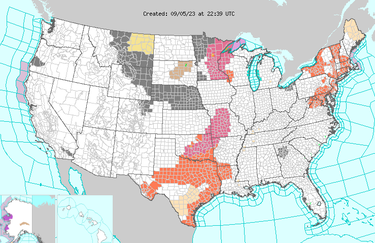With ‘new normal’ of climate change, gov urges being prepared
ALBANY COUNTY — This week, the National Weather Service issued heat advisories for Tuesday and Wednesday with another expected on Thursday for the Mohawk, Hudson, and Connecticut river valleys.
“Hot and humid conditions are expected to continue across some areas on Thursday where another heat advisory will likely be needed,” said the National Weather Service on Tuesday evening. “In addition, there is a chance of thunderstorms Thursday through Sunday, mainly during the afternoon and early evening hours.”
On Tuesday afternoon, the governor’s office put out a release, urging New Yorkers to stay prepared and subscribe to NY-Alert to get real-time weather and emergency alerts during hurricane season. Although there are no current storms in the Atlantic that would directly impact New York state, the release touted Kathy Hochul’s “whole-of-government deployment of resources” in response to the “new normal” of climate change.
The Atlantic hurricane season runs from June 1 through Nov. 30 but usually in New York state, the threat of tropical storms is higher in September and October.
According to the National Oceanic and Atmospheric Administration, there were 14 named hurricanes in 2022 in the Atlantic, which was the seventh consecutive above-average hurricane season. NOAA recently upped its prediction for the 2023 Atlantic hurricane season to include a total of 14 to 21 named storms by the end of the season.
Warming trends on Earth have increased hurricane strength, according to the National Centers for Environmental information.
The heat advisory from the National Weather Service for this week said, “Hot temperatures and high humidity may cause heat illnesses to occur.”
It went on to advise, “Take extra precautions if you work or spend time outside. When possible, reschedule strenuous activities to early morning or evening. Know the signs and symptoms of heat exhaustion and heat stroke.
“Wear lightweight and loose fitting clothing when possible. To reduce risk during outdoor work, the Occupational Safety and Health Administration recommends scheduling frequent rest breaks in shaded or air conditioned environments. Anyone overcome by heat should be moved to a cool and shaded location. Heat stroke is an emergency! Call 9 1 1.”
The state’s health department devotes a page of its website to heat advice. “Heat is on average the greatest weather-related killer in the United States,” the department says. “Heat-related deaths and illness are preventable, yet each year many people suffer from the effects of extreme heat.”
The site lists symptoms of heat exhaustion, including heavy sweating, fainting, vomiting, dizziness, headache, and weakness and advises anyone suffering these symptoms to move to a cool place, loosen clothing, apply wet cloths to the skin, and sip water slowly.
“Heat exhaustion can quickly lead to heat stroke so if symptoms worsen or don’t improve get medical help,” it says.
Symptoms of heat stroke are listed as rapid pulse, body temperature of 105 degrees or higher, confusion, unconsciousness, shallow breathing and red skin. Victims of heat stroke are urged to call 9-1-1 immediately.
The health department says that people most at risk from the heat are children and the elderly, people who are overweight or do not perspire normally, people with chronic medical conditions or people who take medications that interfere with the ability to sweat, and people who work outdoors or in hot settings.
Also this week, Albany County is experiencing “moderate” amounts of particulate matter in the air, according to AirNow.gov. This reading means that people, such as those with asthma, who are unusually sensitive to particle pollution should reduce their activity level or shorten the amount of time they are active outdoors.
There were some days in June and July this year where the air quality was “unhealthy” because of wildfires burning in Canada but lately in Albany county, the air quality has been good.



